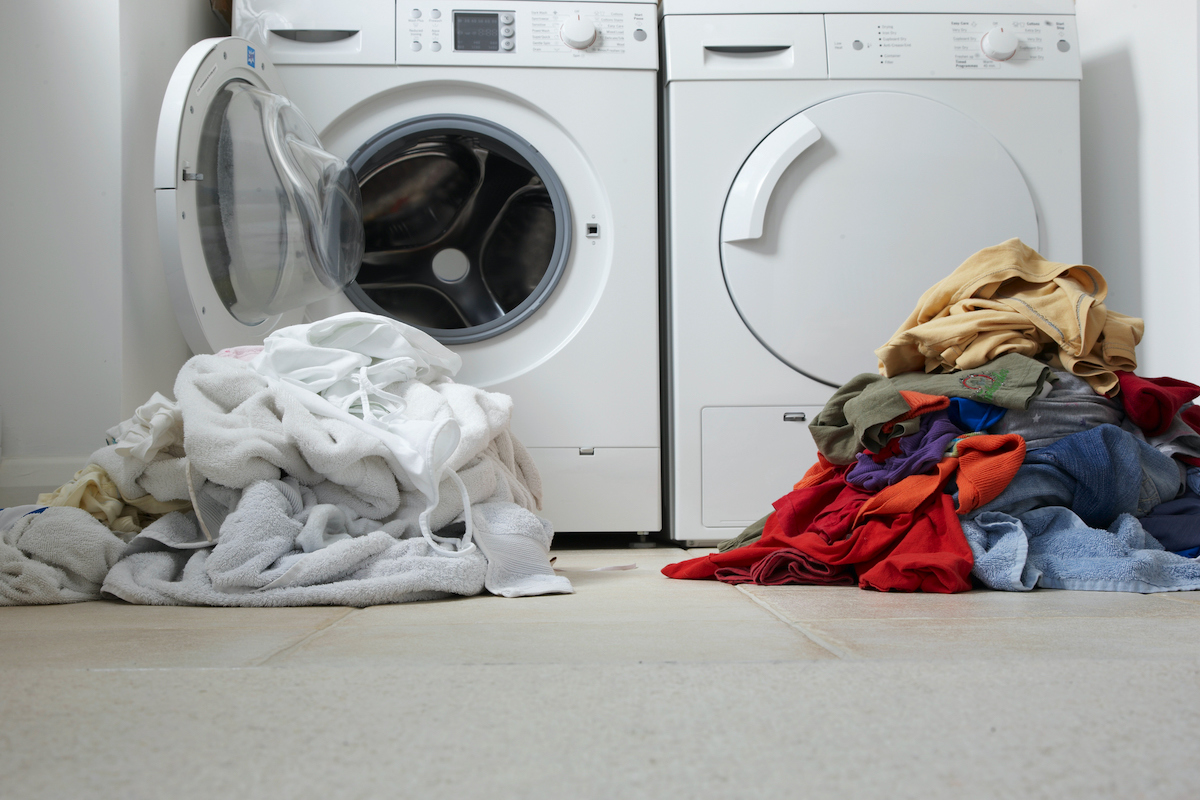We may earn revenue from the products available on this page and participate in affiliate programs. Learn More ›
To sort, or not to sort? That is the question. Many people have strong opinions about sorting laundry. Some see it as an essential task and meticulously sort their clothes into multiple loads based on color and fabric type, while others simply toss everything together in the wash.
So, is sorting laundry even necessary? Does it have an impact on the condition or lifespan of your garments? Read on to learn more about whether you should reconsider your laundry sorting habits.
What are the reasons for sorting laundry?
Most laundry and cleaning experts agree that sorting laundry is important for a variety of reasons. Some of these reasons include:
- Preventing darker dyes from transferring to light-colored clothing items.
- Protecting more delicate clothing items from getting damaged by heavier or abrasive items (such as jeans, zippers, and towels).
- Extending the useful life of your clothes.
- Keeping clothing from being ruined and ending up in a landfill.
Are there situations in which sorting laundry isn’t necessary?
While there are many benefits associated with sorting laundry, there are times when you can more safely get away without sorting a load of clothes. Cold-water washing a load of casual clothing that doesn’t contain any delicates, heavy items, or abrasive materials shouldn’t be a problem as long as you don’t do it often. However, if you make it a habit not to sort out these loads every time, then your clothes may begin to look dingier.

How to Sort Laundry
Use the steps outlined below to sort your laundry before washing it. Consider making your laundry room work for you by purchasing a laundry sorter to help make the process a bit easier.
- Consult the care label for each garment. Note the manufacturer’s recommendations for care, including water temperature and wash cycle. Pull out any dry-clean-only or hand-wash items to handle separately.
- Sort items into two piles: lights and darks. Light colors include white, pastels, and light gray, and darks include black, dark gray, brown, dark blue, and red.
- Go through both piles and sort the clothes a second time, this time by fabric type. Jeans and cotton shirts should not be washed with delicates or synthetics.
- You should not wash any cotton towels or other lint-producing garments or linens with microfiber clothing or blankets. Doing so can lead to pilling.
- Place delicates, such as bras and underwear, in a mesh laundry bag.
- Remove any heavily soiled items from any of the laundry piles. Washing these items separately will help prevent dirt, oil, and other debris from transferring onto your other clothing items.
- Wash and dry each load separately. When multiple loads are combined in the dryer, the lighter items, which will dry more quickly, may become over-dried, causing stress to the fabrics. Heavier items may remain a bit damp, leading to odors on your clothing.
RELATED: Your Laundry Routine Is Probably Outdated—Here’s the Modern Way

Isn’t combining loads better for energy usage and the environment?
While you may think that you’re reducing electricity and water consumption by combining different loads of laundry together, it isn’t quite so simple. When laundry isn’t sorted and washed properly, its lifespan is shortened. This can cause landfills to fill up more quickly, which clearly isn’t good for the environment. Plus, it won’t be good for your wallet when you need to purchase new clothes to replace your worn out and unwearable items.
Moreover, overfilling your washing machine can also cause more wear on the machine. Extending the life of your washer—even by a few months or years—by sorting your laundry can reduce waste and save you money in the long run.
What happens if you don’t sort laundry?
While there are many things you can clean in a washing machine, that doesn’t mean it should all be washed in the same load. If you don’t sort your laundry, you run the risk of ruining your clothes or significantly decreasing their lifespans. The results could be instant, such as your favorite white blouse turning pink after being washed with a red sock, or they might be more gradual, like your cotton shirts pilling from being washed repeatedly with jeans or other heavy items.
Either way, it is best to develop a laundry sorting routine and stick with it to protect the investment you made when picking out your wardrobe.

Can you fix damage caused by mixing lights and darks?
Regardless of whether those loads of lights and darks were accidentally or intentionally combined into one, opening the lid to see that darker dye transferred to the whites or lighter items can be crushing. While you may not be able to completely undo the damage, if you work quickly, there are a few things that could help minimize the effects on your garments.
Follow the steps below to see if you can salvage any of the damaged clothing items before setting the stains in the dryer—another one of the top laundry mistakes people make.
- Remove any items from the washing machine that were stained by the dye transfer.
- Move any non-color stained clothing to the dryer and start a dry cycle.
- Return the color-stained items to the washing machine.
- Choose an agitate cycle on your washing machine and run it on a cold water setting. Let it run for about 5 minutes.
- Add ½ cup color-safe or chlorine bleach (for loads where all the items were previously white). If you’d prefer not to use bleach, you can use 1 cup of distilled white vinegar instead.
- Turn the agitate cycle back on for an additional 5 minutes.
- After 5 minutes, stop the cycle and let the clothing sit in the tub of water and bleach or vinegar for 15 to 20 minutes.
- Select a spin cycle to drain the water from the machine.
- Add detergent to the machine and run a normal cold wash cycle.
- After the cycle finishes, take a close look at each clothing item. Repeat the above steps if color stains are still present, or move the items to the dryer if they look good.
RELATED: The Best Washing Machine Brands


